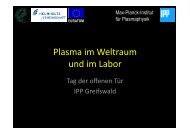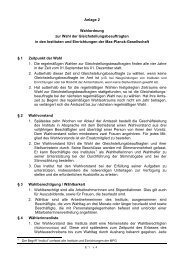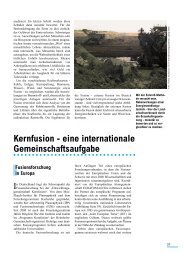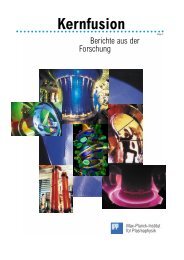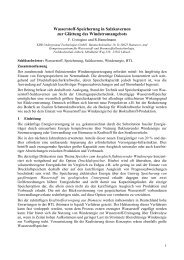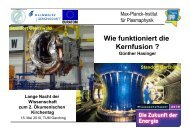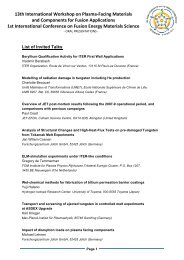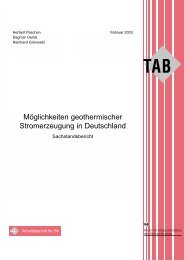IPP Annual Report 2007 - Max-Planck-Institut für Plasmaphysik ...
IPP Annual Report 2007 - Max-Planck-Institut für Plasmaphysik ...
IPP Annual Report 2007 - Max-Planck-Institut für Plasmaphysik ...
Create successful ePaper yourself
Turn your PDF publications into a flip-book with our unique Google optimized e-Paper software.
Additionally all incoming electronic mail is scanned for<br />
viruses and only clean and unobjectionable data (based on<br />
known problems) will be passed to the internal network, the<br />
rest gets quarantined. Spam mail marking is also active.<br />
Based on a level of probability users can define and set filter<br />
threshold values at their PC’s email client. In addition the<br />
individual activation of “greylisting” drastically reduces the<br />
incoming of unwanted emails.<br />
After having successfully renovated the old building of the<br />
computer center, a very flexible passive network structure<br />
with fixed and hidden loose cables has been installed. The<br />
active part of the data network is made up of a state-of-theart<br />
high-performance switch-router Foundry MLX, where<br />
all the supercomputer and server nodes get attached with the<br />
highest performance available. The coupling of the new<br />
BlueGene/P system with the storage subsystems was accomplished<br />
with a 10-Gigabit-only Force10-E600 switch-router.<br />
Data Acquisition and Data Bases for Plasma Fusion<br />
Experiments<br />
The main task of the XDV group at the computer center in<br />
Garching is to develop the data acquisition and data storage<br />
system for the W7-X experiment in Greifswald. This work<br />
is done in close cooperation with the experiment control<br />
group, the data analysis group as well as the diagnostic and<br />
physics department.<br />
The scheduling of the long discharges of W7X will be done by<br />
predefining operational parameters in segments and scenarios.<br />
Segments are valid for a certain amount of time and a scenario<br />
is a fixed sequence of segments with a special physical background.<br />
These segments contain very detailed but necessary<br />
information for the hardware and software to operate the discharge.<br />
Apart from the technical view of the segments the<br />
experiment leader or physicist needs a more physical view to<br />
the discharge description. Therefore an abstraction layer was<br />
introduced that only shows physically interesting information<br />
(high-level parameters). An executable segment will be generated<br />
after verifying the consistency of these high-level parameters<br />
by using a transformation function for every technical<br />
parameter involved. The definition of the necessary structures<br />
and interfaces is finished and by the end of <strong>2007</strong> some sample<br />
implementations of transformation functions have been<br />
available. The implementation of object life cycles, object<br />
states and user access rights on objects is completed. The<br />
package is used by the editors to visualize object properties<br />
and to handle access to objects in a safe and consistent way.<br />
By the end of <strong>2007</strong> the generic editor (Confix) for the structures<br />
in the data base has reached its intended functionality.<br />
The Confix editor works on all kind of objects in the data base<br />
and can only safely be used by an experienced user who knows<br />
about the structure and the object relations. The physicists<br />
need much simpler and more specialized editors for defining<br />
Computer Center Garching<br />
98<br />
configurations, segments and scenarios. The introduction of<br />
the physics abstraction layer with the high-level parameters<br />
is the basis for these editors and reduces the information presented<br />
to the user considerably. At the moment two editors are<br />
in development and first versions with basic functionality<br />
are already available. The group configuration editor is used<br />
to edit and define the description of components containing<br />
several control stations (fast control stations and data acquisition<br />
stations). It handles stations, the communication description<br />
necessary to operate the stations as well as the<br />
definition of the high-level parameters and the corresponding<br />
transformation functions. The segment editor has all the features<br />
to handle segment descriptions for components and<br />
projects. If not specified differently all high-level parameters<br />
are displayed in a standard way. If anything is changed, the<br />
segments may be saved and by using the specified transformation<br />
function, translated to the technical description used<br />
for machine operation. Both editors use the life cycle package<br />
to handle access rights and segment states correctly.<br />
The implementation of the complete control and data acquisition<br />
system of W7X on the already existing and simpler<br />
WEGA device reaches its first milestone at the beginning of<br />
2008. The control and data acquisition will then be replaced<br />
by the new system. At the moment the first test runs are<br />
accomplished and show promising results. Continuing tests<br />
will also incorporate physicists of W7-X to show the efficiency<br />
of the user interfaces and structures.<br />
Initiated by the ASDEX-Upgrade CODAC (Control and Data<br />
Acquisition) team, a new standard data acquisition station<br />
was defined and constructed. Based on the serial optical link<br />
(Hotlink standard) and a proprietary backplane defined locally,<br />
several remotely available ADCs of various sample speeds<br />
can be connected to any standard computers equipped with<br />
PCI or Compact PCI slots. This solution allows the build-up<br />
of data acquisition systems with a large number of channels.<br />
Staff<br />
A. Altbauer, G. Bacmeister, V. Bludov, G. Bronold, R. Bruckschen,<br />
J. Daschner, K. Desinger, R. Dohmen, R. Eisert * , I. Fischer,<br />
S. Groß * , K. Gross, C. Guggenberger, A. Hackl, C. Hanitsch,<br />
C. Hanke, R. Hatzky, S. Heinzel, F. Hinterland, M. Kölbl,<br />
G. Kühner * , H. Lederer, K. Lehnberger, J. Mejia, K. Näckel * ,<br />
W. Nagel, M. Panea-Doblado, F. Paulus, A. Porter-Sborowski,<br />
M. Rampp, J. Reetz, H. Reuter, K. Ritter, S. Sagawe * ,<br />
R. Schmid, A. Schmidt, H. Schürmann * , J. Schuster,<br />
U. Schwenn, T. Soddemann, R. Tišma, S. Valet * , I. Weidl.<br />
Data Acquisition Group: T. Bluhm * , P. Heimann, C. Hennig * ,<br />
G. Kühner * , J. Maier, Ch. Meyer, H. Riemann * , M. Zilker.<br />
* <strong>IPP</strong> Greifswald




